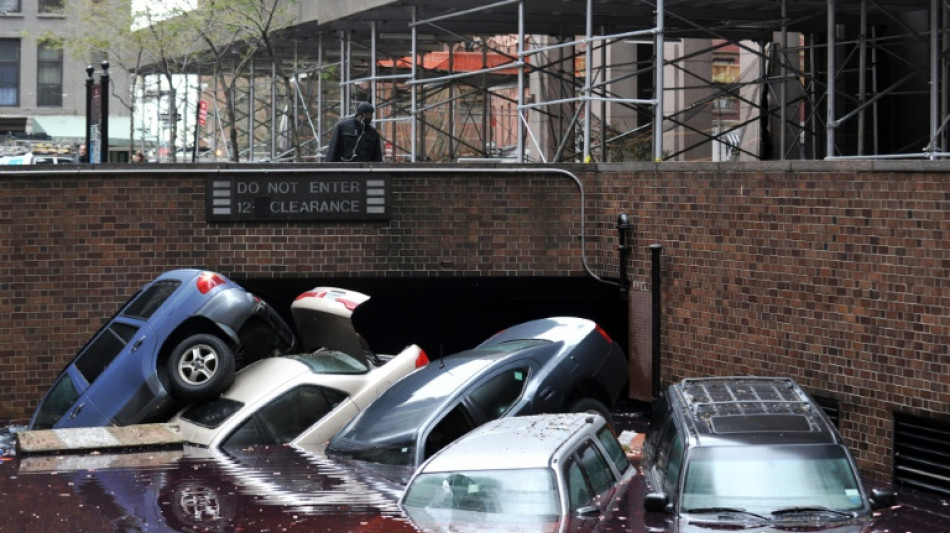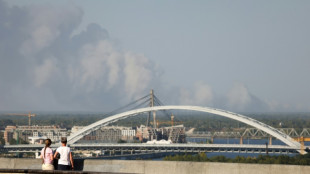
-
 Davis Cup organisers hit back at critics of Nadal retirement ceremony
Davis Cup organisers hit back at critics of Nadal retirement ceremony
-
Noel in a 'league of his own' as he wins Gurgl slalom

-
 A dip or deeper decline? Guardiola seeks response to Man City slump
A dip or deeper decline? Guardiola seeks response to Man City slump
-
Germany goes nuts for viral pistachio chocolate

-
 EU urges immediate halt to Israel-Hezbollah war
EU urges immediate halt to Israel-Hezbollah war
-
Far right targets breakthrough in Romania presidential vote

-
 Basel votes to stump up bucks to host Eurovision
Basel votes to stump up bucks to host Eurovision
-
Ukraine shows fragments of new Russian missile after 'Oreshnik' strike

-
 IPL auction records tumble as Pant and Iyer snapped up
IPL auction records tumble as Pant and Iyer snapped up
-
Six face trial in Paris for blackmailing Paul Pogba

-
 Olympic champion An wins China crown in style
Olympic champion An wins China crown in style
-
It's party time for Las Vegas victor Russell on 'dream weekend'

-
 Former Masters champion Reed seals dominant Hong Kong Open win
Former Masters champion Reed seals dominant Hong Kong Open win
-
Norris applauds 'deserved' champion Verstappen

-
 Jaiswal and Kohli slam centuries as Australia stare at defeat
Jaiswal and Kohli slam centuries as Australia stare at defeat
-
Kohli blasts century as India declare against Australia

-
 Verstappen 'never thought' he'd win four world titles
Verstappen 'never thought' he'd win four world titles
-
Former Masters champion Reed wins Hong Kong Open

-
 Awesome foursomes: Formula One's exclusive club of four-time world champions
Awesome foursomes: Formula One's exclusive club of four-time world champions
-
Smylie beats 'idol' Cameron Smith to win Australian PGA Championship

-
 Five key races in Max Verstappen's 2024 title season
Five key races in Max Verstappen's 2024 title season
-
Max Verstappen: Young, gifted and single-minded four-time F1 champion

-
 'Star is born': From homeless to Test hero for India's Jaiswal
'Star is born': From homeless to Test hero for India's Jaiswal
-
Verstappen wins fourth consecutive Formula One world title

-
 Survivors, sniffing dogs join anti-mine march at Cambodia's Angkor Wat
Survivors, sniffing dogs join anti-mine march at Cambodia's Angkor Wat
-
Far right eye breakthrough in Romania presidential vote

-
 Jaiswal slams majestic 161 but Australia fight back in Perth
Jaiswal slams majestic 161 but Australia fight back in Perth
-
Edinburgh's alternative tour guides show 'more real' side of city

-
 IPL teams set to splash the cash at 'mega-auction' in Saudi Arabia
IPL teams set to splash the cash at 'mega-auction' in Saudi Arabia
-
Olympics in India a 'dream' facing many hurdles

-
 Wounded Bangladesh protesters receive robotic helping hand
Wounded Bangladesh protesters receive robotic helping hand
-
Majestic Jaiswal 141 not out as India pile pain on Australia

-
 Giannis, Lillard lead Bucks over Hornets as Spurs beat Warriors
Giannis, Lillard lead Bucks over Hornets as Spurs beat Warriors
-
Juan Mata agent slammed as 'cowardly' by angry A-League coach

-
 Marta inspires Orlando Pride to NWSL title
Marta inspires Orlando Pride to NWSL title
-
Palestinian pottery sees revival in war-ravaged Gaza

-
 Main points of the $300 billion climate deal
Main points of the $300 billion climate deal
-
Robertson wants policy change for overseas-based All Blacks

-
 Israel retreat helps rescuers heal from October 7 attack
Israel retreat helps rescuers heal from October 7 attack
-
Afghan women turn to entrepreneurship under Taliban

-
 Mounting economic costs of India's killer smog
Mounting economic costs of India's killer smog
-
At climate talks, painstaking diplomacy and then anger

-
 Uruguayans head to polls with left hoping for comeback
Uruguayans head to polls with left hoping for comeback
-
Trump's mass deportation plan could end up hurting economic growth

-
 Iran director in exile says 'bittersweet' to rep Germany at Oscars
Iran director in exile says 'bittersweet' to rep Germany at Oscars
-
US consumers to bargain hunt in annual 'Black Friday' spree

-
 Cheers, angst as US nuclear plant Three Mile Island to reopen
Cheers, angst as US nuclear plant Three Mile Island to reopen
-
Scientists seek miracle pill to stop methane cow burps

-
 Australia ditches plans to fine tech giants for misinformation
Australia ditches plans to fine tech giants for misinformation
-
Developing nations slam 'paltry' $300 bn climate deal


A decade post-Sandy, New York vulnerable as ever
Long before Superstorm Sandy devastated New York City and the surrounding region in 2012, scientist Klaus Jacob issued a prophetic report warning city leaders that such paralyzing flooding was imminent.
Then Sandy made landfall on October 29 of that year, leaving well over 100 people dead in the United States, including 43 New York City residents. It caused $19 billion in damages across the metropolis, triggering lengthy power outages, temporarily displacing thousands of people and damaging tens of thousands of residential units.
More than two feet of water flooded into Jacob's own home in a quaint Hudson River town in New York state, an irony he suffered because municipal zoning laws barred him from raising the building enough to avoid such inundation.
"A week after Sandy I got a letter in the mail: 'Now you can raise it,'" recounted Jacob, a geophysicist at Columbia University specializing in disaster risk management.
The experience speaks to the much larger challenges of short-sighted thinking as climate change warnings grow ever-more dire.
Ten years after Sandy left one of the world's cultural and economic powerhouses tragically swamped, Jacob says the city is far from prepared for the coming era of intense storms.
New York received billions of federal dollars and invested in rebuilding. A number of resiliency projects remain in the planning stages while a few, including one to reduce Manhattan's coastal flood risk, are underway.
Jacob said subway repairs that fixed thousands of holes would allow the vital transportation system to fare better in the wake of another Sandy-esque storm.
And the US Army Corps of Engineers recently detailed a $52 billion plan to erect a massive system of storm surge gates and seawalls.
But that will require years of bureaucracy to get approvals, and isn't slated to begin construction until 2030.
- Climate and housing -
An October report from New York's comptroller -- an elected official responsible for scrutinizing the budget -- criticized some city agencies for dawdling, with several projects stalled and billions in federal funding unused and still available.
Last fall's Hurricane Ida meanwhile highlighted the city's persistent frailties, including aging sewer infrastructure.
In a mere hour Ida poured more than three inches of rain onto Central Park -- nearly twice what the city's sewage system is capable of handling -- and, according to Jacob, "the subway system became the default sewer system."
Dozens of people in the region died. Several of the deceased lived in New York City basement apartments that flooded.
If Sandy hit tomorrow "we'd be way worse off," said Thaddeus Pawlowski, an urban designer focused on climate resiliency, who formerly worked at the NYC Office of Emergency Management.
"Our housing situation has gotten so much worse. Our neighborhoods are so much more unequal," Pawlowski told AFP.
New York is facing an acute housing crisis, but a fair proportion of the city's new residencies have been in coastal neighborhoods like Williamsburg and Long Island City. Municipal data mapped by local outlet The City shows some 2,000 new units were built square in the floodplain of Coney Island, a district Sandy pummeled.
The state has bought out some homeowners living in vulnerable neighborhoods, including in Staten Island's Ocean Breeze, where hundreds of homes were purchased and demolished.
"That's a good pilot program, but it's bread crumbs -- we need loaves," said Jacob. "Buying out is not enough. We need to have a place where they can move."
Jacob cited need for denser residential buildings, but emphasized new construction must eye climate risk rather than cater to the real estate industry.
"We don't have any long-term vision, such that short-term measures, like building housing, work together with that long-term vision," he told AFP.
"Without that vision being developed, I think we are just fiddling around forever on the edges."
- 'Massive mobilization' -
Climate experts and political leaders agree there's no silver bullet -- mitigating risk and shoring up resiliency demands sweeping planning and investment in conjunction with neighborhood-scale storm management, like shrub-filled bioswale ditches that filter runoff.
"We are not going to be able to say, 'we did one project and now we are safe forever,'" said Rohit Aggarwala, the city's chief climate officer. "That just is not the way it is going to work."
Pawlowski pointed to the Green New Deal -- a proposed congressional plan to reshape America's climate and economic policy -- as a way forward.
"We need a massive mobilization," he said.
Jacob did say that, unlike some of the United States' low-lying coastal cities like New Orleans, New York has "the luxury of high typography" that should inform building strategies.
Perhaps morbidly, he noted the city's cemeteries occupy its highest points: "We could swap the dead and the living."
Above all, Jacob urged against inertia, saying "either we are psychologically overwhelmed, or the water will overwhelm us."
"Which one do you prefer?"
O.Bulka--BTB



